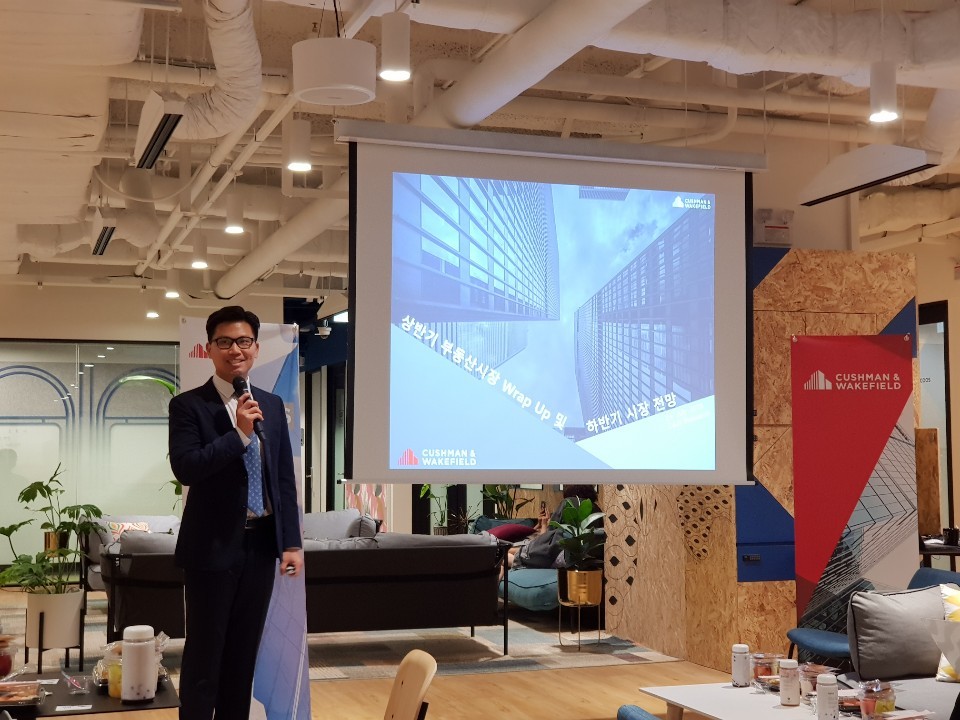After picking up last year amid a slowing economy, Seoul’s office building market is likely to catch its breath in the upcoming months and peak next year as large-sized premium buildings spill into the market for sale and lease, according to commercial real estate company Cushman & Wakefield.
“Since 2010, the office building market (in Seoul’s key business districts) has mostly seen supply outrun demand,” Philip Jin, head of research at the Korean office of the US-based real estate service provider, said in a press conference Wednesday.
“But this year, the market will largely be demand-driven as the supply (of available buildings for sale) will remain low throughout the rest of the year.”
 |
Philip Jin, head of research at Cushman & Wakefield Korea (Bae Hyun-jung/The Korea Herald) |
Due to limited supply, the vacancy level also diminished visibly in popular business zones across the capital city during recent months, the company’s data showed.
Seoul’s average vacancy rate for A-list office buildings as of the second quarter stood at 9.4 percent. Leading the change was Yeouido Business District, which saw a corresponding vacancy rate of 9.3 percent, marking the first single-digit figure since the local landmark International Finance Centre kicked off in 2012.
The other two index areas, the Central Business District and Gangnam Business District, stood at 13.7 percent and 3.5 percent, respectively.
The current market model, however, will only last temporarily while the market braces to gain further momentum next year, the analyst suggested.
According to a market report released by the company in January this year, the total volume of office building transactions here totaled a record-high 11.4 trillion won ($9.7 billion) last year on the back of mega deals priced over 1 trillion won.
One of the game changers was Seoul Square -- a 23-story, 132,806 square-meter building located across Seoul Station -- which was acquired by NH Investment & Securities for around 980 billion won in the first quarter.
Such landmark deals continued to stimulate the office building market here this year, despite the slowing growth pace and growing external risks faced by Asia’s fourth-largest economy.
The volume of office building transactions in Seoul was estimated at 5.9 trillion won as of end-June, up 5 percent from a year earlier, when the figure reached a record-breaking level.
This on-year growth indicated that the market for prime office buildings has continued to flourish, though Seoul’s policymakers have been responding to downside economic risks by lowering the growth outlook and key interest rate.
But the total volume of office building transactions is likely to linger around 10 trillion won by year-end, down from last year’s record 11.4 trillion won, the analyst suggested.
“Though no significant large-sum deals are slated for the remaining half of the year, we expect several landmark articles to roll out in the market next year,” Jin said.
The company predicted that at least 713,632 square meters of new office space would be available in the market next year.
“As our survey and outlook tend to be focused on large-sized offices with gross area of 33,000 square meters or more, the actual market supply will outrun this figure,” he added.
Considering the slowing growth outlook and lowered key interest rate, the market’s liquidity -- both from inbound foreign investors and local investors -- will likely stay tuned to the relatively profitable value-added office building real estate market next year, according to the company.
By Bae Hyun-jung (
tellme@heraldcorp.com)




![[Herald Interview] 'Trump will use tariffs as first line of defense for American manufacturing'](http://res.heraldm.com/phpwas/restmb_idxmake.php?idx=644&simg=/content/image/2024/11/26/20241126050017_0.jpg)

![[Health and care] Getting cancer young: Why cancer isn’t just an older person’s battle](http://res.heraldm.com/phpwas/restmb_idxmake.php?idx=644&simg=/content/image/2024/11/26/20241126050043_0.jpg)

![[Graphic News] International marriages on rise in Korea](http://res.heraldm.com/phpwas/restmb_idxmake.php?idx=644&simg=/content/image/2024/11/25/20241125050091_0.gif)